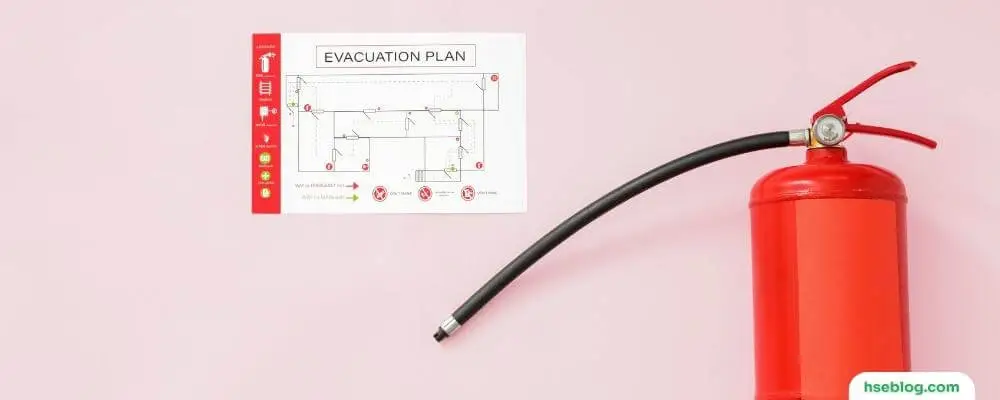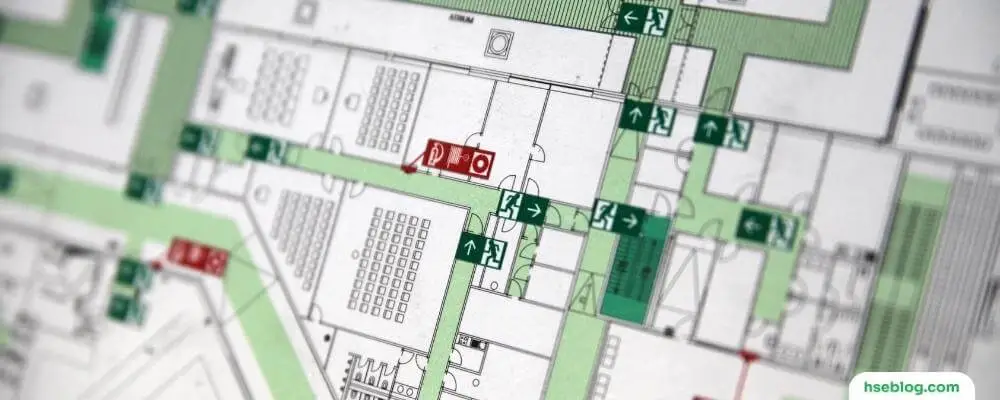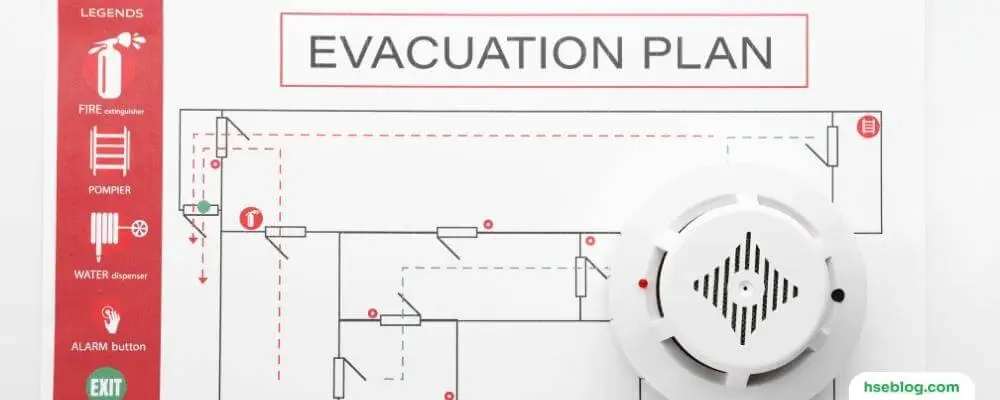Fire safety is critical for building owners, managers, and occupants. A well-prepared Fire Evacuation Plan (FEP) can mean the difference between life and death in a fire emergency. A Fire Evacuation Plan outlines the procedures and steps occupants should follow in a fire emergency.
In this blog, we will discuss the 10 essential elements of a Fire Evacuation Plan that are crucial for ensuring the safety of building occupants during a fire emergency. We will cover topics such as clearly marked emergency exits, designated evacuation routes, safe assembly points, roles and responsibilities of building occupants, communication systems and procedures, training and drills, firefighting equipment and maintenance, special considerations for people with disabilities, regular review and updating of the plan, and compliance with local regulations and codes.
By understanding and implementing these essential elements, building owners and managers can create a safer environment for their occupants and minimize the risk of injury or loss of life in a fire emergency.
What Is a Fire Evacuation Plan?
A Fire Evacuation Plan (FEP) is a comprehensive document that outlines the procedures and steps that building occupants should follow in a fire emergency. The FEP provides a clear and concise plan of action to ensure all building occupants’ safe and efficient evacuation and minimize the risk of injury or loss of life during a fire emergency.
A well-prepared Fire Evacuation Plan is crucial for ensuring the safety of building occupants during a fire emergency. It provides occupants with clear instructions and procedures to follow, which can help reduce panic and confusion during a high-stress situation. A well-designed and implemented FEP can also help minimize the spread of a fire, reducing property damage and potential injuries.
Additionally, the law often requires compliance with local fire codes and regulations, and failure to comply can result in penalties and legal action. Therefore, it is essential to develop and maintain an effective Fire Evacuation Plan for any building to ensure the safety of its occupants and compliance with local regulations.

10 Essential Elements Of Fire Evacuation Plan
A fire evacuation plan is essential for keeping people safe in a fire. It outlines the procedures that should be followed when a fire occurs, including how to safely exit the building, where to go, and what to do once outside. The following are the essential elements of a fire evacuation plan:
1. Clearly Marked Emergency Exits
One of the most crucial aspects of a Fire Evacuation Plan (FEP) is ensuring that all emergency exits are clearly marked and easily accessible. This helps occupants quickly locate exit points and escape the building in a fire. To achieve this, consider the following:
- Visibility: Emergency exit signs should be highly visible, even in low light or smoky conditions. They should be illuminated, use reflective or glow-in-the-dark materials, and be placed at a height easily seen from a distance.
- Clear pathways: All pathways leading to emergency exits should be free from obstacles and clutter. Regular inspections should ensure that exit routes remain unobstructed at all times.
- Proper signage: Exit signs should be displayed above or adjacent to exit doors and follow local regulations and guidelines. Directional signs indicating the way to emergency exits should also be posted throughout the building.
- Door functionality: Emergency exit doors must be easy to open and operate, even during a power outage. They should not be locked or blocked in any way that could prevent occupants from using them during an emergency.
- Multiple exits: Buildings should have multiple emergency exits to provide alternative escape routes if one becomes inaccessible due to fire or smoke. This helps ensure that occupants can evacuate the building safely and quickly.
- Maintenance: Regular maintenance and inspections should be conducted to ensure that emergency exit doors, signage, and lighting are in good working order. Any issues should be addressed promptly to maintain the effectiveness of the FEP.
By implementing these measures, you can ensure that the emergency exits in your building are clearly marked and easily accessible, contributing to a safer and more effective Fire Evacuation Plan.
2. Designated Evacuation Routes
Designated evacuation routes play a critical role in a Fire Evacuation Plan (FEP) as they guide occupants safely out of the building during an emergency. These routes should be carefully planned and communicated to ensure a quick and efficient evacuation. To establish effective evacuation routes, consider the following steps:
- Risk assessment: Begin by conducting a thorough risk assessment of the building to identify potential hazards, such as flammable materials or high-traffic areas. This information can help you determine the most appropriate evacuation routes.
- Route planning: Design evacuation routes that provide the shortest and most direct path to emergency exits. Ensure that routes avoid potential hazards, such as blocked or locked doors, and consider the needs of individuals with disabilities or mobility limitations.
- Alternative routes: Develop evacuation routes if the primary route becomes impassable due to fire, smoke, or other obstacles. This ensures that occupants have multiple options for safely exiting the building.
- Clear signage: Clearly mark evacuation routes with signs and maps that are easy to read and understand. Display them prominently throughout the building, especially near stairwells, elevators, and other key areas.
- Accessibility: Ensure evacuation routes are accessible to all building occupants, including those with disabilities or mobility impairments. This may involve installing ramps, handrails, or other accommodations to facilitate a smooth evacuation.
- Regular inspections: Routinely inspect evacuation routes to verify that they remain clear and unobstructed. Address any issues or obstructions promptly to maintain the effectiveness of the FEP.
- Communication: Inform all building occupants of the designated evacuation routes, and provide training to follow them during an emergency. This may include distributing maps, conducting walkthroughs, or hosting safety meetings to ensure everyone knows the routes.
- Drills and exercises: Regularly conduct fire drills to help occupants practice using the designated evacuation routes. This will help them become familiar with the routes and allow any adjustments or improvements based on feedback and observations.
By carefully planning and maintaining designated evacuation routes, you can enhance the effectiveness of your Fire Evacuation Plan and ensure the safety of all building occupants during an emergency.

3. Safe Assembly Points
Safe assembly points are pre-determined locations where building occupants gather after evacuating during an emergency, such as a fire. These points are critical in a Fire Evacuation Plan (FEP) as they help account for all individuals and ensure their safety. To establish effective, safe assembly points, consider the following guidelines:
- Location: Choose assembly points at a safe distance from the building, typically a minimum of 50 feet or more, depending on the size and nature of the structure. This protects occupants from fire, smoke, or falling debris.
- Accessibility: Ensure assembly points are accessible to all building occupants, including those with disabilities or mobility impairments. Locations should be reachable via the designated evacuation routes and have sufficient space to accommodate everyone.
- Visibility: Select assembly points that are easy to locate and identify. Use clear signage to mark the area, and consider using brightly colored flags, cones, or other visual indicators to make the location easily distinguishable.
- Multiple assembly points: Designate multiple assembly points for larger buildings or facilities to prevent overcrowding and to ensure that all occupants have a nearby location to gather.
- Shelter: If possible, choose assembly points that provide some shelter from the elements, such as trees, awnings, or structures. This can be especially important during extreme weather conditions or for extended evacuations.
- Communication: Clearly communicate the location of assembly points to all building occupants. Provide maps or diagrams, and include this information in safety briefings, training sessions, and evacuation drills.
- Roll call and accountability: Assign a designated person or team to conduct a roll call or headcount at the assembly point to account for all building occupants. This helps ensure everyone has safely evacuated and allows emergency personnel to identify missing individuals.
- Coordination with emergency services: Inform local emergency services, such as fire departments, of the designated assembly points. This facilitates better coordination during an emergency and ensures that responders know where to find evacuees.
- Regular review: Periodically review and update the location of assembly points, particularly if there have been changes to the building layout, occupancy, or surrounding environment.
By carefully selecting and maintaining safe assembly points, you can ensure the well-being of all building occupants during an emergency and enhance the effectiveness of your Fire Evacuation Plan.
4. Roles And Responsibilities Of Building Occupants
In a Fire Evacuation Plan (FEP), it is essential to define the roles and responsibilities of building occupants to ensure a well-coordinated and efficient response during an emergency. Clearly assigning duties and expectations helps everyone understand their part in the evacuation. Consider the following roles and responsibilities for building occupants:
- Building Owner or Manager: The building owner or manager is responsible for developing, implementing, and maintaining the FEP. They should ensure that all safety equipment and systems are regularly inspected and that all occupants are trained and informed about the plan.
- Fire Wardens or Floor Wardens: Designate individuals as fire wardens or floor wardens responsible for assisting with evacuations on their assigned floors or areas. Their tasks may include directing occupants to the nearest exit, checking rooms for remaining occupants, and assisting individuals with disabilities or mobility impairments.
- Evacuation Team: Assemble an evacuation team comprising volunteers or designated employees trained to assist with emergency evacuations. Their responsibilities may include guiding occupants along evacuation routes, providing crowd control, and offering support at assembly points.
- First Aid Team: Establish a team to assist with injuries or medical emergencies during an evacuation. Members should be trained in basic first aid and CPR and have access to appropriate first aid supplies.
- Communication Team: Assign a team to handle communication during an emergency, including contacting emergency services, providing updates to occupants, and sharing information with the media or external stakeholders, if necessary.
- General Occupants: All building occupants should be familiar with the FEP and understand their responsibilities, such as following evacuation routes, gathering at assembly points, and following the directions of fire wardens or evacuation team members. Occupants should also be aware of the location of fire extinguishers, alarm systems, and emergency exits.
- Regular Training: Conduct regular training sessions for all occupants to ensure they understand their roles and responsibilities during an emergency. This may include fire drills, safety briefings, or hands-on practice with firefighting equipment.
- Post-Evacuation Responsibilities: Assign roles for the aftermath of an evacuation, such as accounting for all occupants, assessing building damage, and coordinating with emergency services and insurance providers.
By defining the roles and responsibilities of building occupants, you can create a more efficient and effective Fire Evacuation Plan that ensures everyone’s safety during an emergency.

5. Communication System And Procedures
Effective communication is critical during a fire emergency to ensure that building occupants are informed of the situation, receive instructions and can respond accordingly. Establishing a reliable communication system and procedures can significantly improve the efficiency of your Fire Evacuation Plan (FEP). Consider the following guidelines for developing communication systems and procedures:
- Alarm Systems: Install and maintain fire alarm systems that promptly alert building occupants of a fire or emergency. These systems should include both visual and audible alarms to accommodate individuals with hearing or visual impairments.
- Public Address Systems: Implement a public address (PA) system or intercom to allow real-time communication with occupants during an emergency. This enables designated personnel to provide updates, instructions, or evacuation orders as needed.
- Emergency Notifications: Develop a method for sending emergency notifications via phone, text, email, or a dedicated app to building occupants. This can help ensure that everyone receives timely information about an emergency, even if they are not near the building.
- Two-Way Radios: Equip key personnel, such as fire wardens, evacuation team members, or building management, with two-way radios to facilitate communication during an evacuation. This allows for efficient coordination and addressing of any issues during evacuation.
- Clear Procedures: Establish clear procedures for communicating during an emergency, including who is responsible for initiating the alarm, contacting emergency services, providing updates to occupants, and managing external communications (such as with the media or neighboring businesses).
- Language and Clarity: Ensure all emergency communications are concise and easily understood. Consider the language needs of your building occupants, and provide translations or multilingual materials as necessary.
- Training and Drills: Incorporate communication procedures into training sessions and evacuation drills to ensure that all occupants are familiar with the methods and protocols for emergency communication.
- Backup Communication Methods: Develop contingency plans for communication in case primary systems fail or become unavailable during an emergency. This may include backup PA systems, alternative notification methods, or portable loudspeakers.
By implementing a comprehensive communication system and procedures, you can help ensure that building occupants are well-informed and able to respond effectively during a fire emergency, ultimately contributing to a more successful Fire Evacuation Plan.
6. Training And Drills
Training and drills are essential components of a Fire Evacuation Plan (FEP) as they ensure that building occupants are familiar with emergency procedures and can respond effectively during a real-life fire. Regular practice and training sessions help reinforce key concepts, identify areas for improvement, and build confidence in handling emergencies. Consider the following guidelines for implementing training and drills:
- Regular Fire Drills: Schedule fire drills at regular intervals, such as every six months or annually, depending on the size and nature of your building or as mandated by local regulations. Unannounced drills can also be conducted to simulate a real emergency and test the readiness of occupants.
- Scenario-based Training: Create training sessions that incorporate various scenarios, such as blocked exits, power outages, or the presence of smoke, to better prepare occupants for different situations they may encounter during an actual emergency.
- Hands-on Practice: Provide hands-on training with fire safety equipment, such as fire extinguishers, fire blankets, and evacuation chairs. This helps occupants become familiar with the proper use of these tools and ensures they are better prepared in case of a fire.
- Emergency Communication Training: Teach building occupants about the communication systems and procedures in place, including how to use public address systems, receive emergency notifications, and communicate with fire wardens or evacuation team members.
- Role-specific Training: Provide specialized training for individuals with assigned emergency roles, such as fire wardens, evacuation team members, or first aid responders. Ensure they are well-prepared to execute their duties during an emergency.
- Training for Individuals with Disabilities: Offer tailored training sessions for occupants with disabilities or mobility impairments to ensure they understand and are comfortable with the evacuation procedures.
- Review and Evaluation: After each training session or drill, conduct a debriefing to review the effectiveness of the FEP and identify any areas for improvement. Encourage feedback from building occupants to address concerns or suggestions for enhancing the plan.
- Documentation: Keep records of all training sessions and drills, including dates, participants, and any observations or lessons learned. This documentation can be helpful for future planning and demonstrating compliance with local regulations.
By incorporating regular training and drills into your Fire Evacuation Plan, you can help ensure that building occupants are well-prepared for emergencies, ultimately increasing the likelihood of a successful evacuation and minimizing the risk of injury or loss of life.

7. Firefighting Equipment And Maintenance
Firefighting equipment plays a crucial role in a Fire Evacuation Plan (FEP), as it can help mitigate the spread of a fire, protect building occupants, and potentially save lives. Ensuring appropriate firefighting equipment is available, well-maintained, and easily accessible is vital for an effective FEP. Consider the following guidelines for managing firefighting equipment and maintenance:
- Selection of Equipment: Install appropriate firefighting equipment based on the size, layout, and potential fire hazards within your building. Common equipment includes fire extinguishers, fire blankets, automatic sprinkler systems, and smoke detectors.
- Proper Placement: Ensure firefighting equipment is strategically placed throughout the building, making it easily accessible to occupants. Fire extinguishers and blankets should be near potential fire hazards, such as kitchens or electrical panels, along evacuation routes.
- Signage and Visibility: Clearly mark the location of firefighting equipment with visible signage. Ensure that equipment is not obstructed and can be quickly located and accessed during an emergency.
- Equipment Maintenance: Regularly inspect and maintain firefighting equipment to ensure it is in good working order. This may include checking fire extinguishers’ pressure and expiration dates, testing smoke detectors, and inspecting sprinkler systems.
- Professional Inspections: Schedule periodic professional inspections of firefighting equipment and systems as required by local regulations or industry standards. Address any issues identified during these inspections promptly to maintain the effectiveness of your FEP.
- Training: Train building occupants on properly using firefighting equipment, including how to operate fire extinguishers, deploy fire blankets, and activate manual fire alarms. Familiarize them with the locations of the equipment within the building.
- Replacement and Upgrades: Replace expired or damaged firefighting equipment as needed and consider upgrading to newer, more effective models as they become available.
- Compliance with Regulations: Ensure your building’s firefighting equipment meets all local codes, regulations, and industry standards. Regularly review these requirements and make necessary adjustments to stay in compliance.
By properly managing and maintaining firefighting equipment, you can help ensure that your building and its occupants are better protected in the event of a fire. This, in turn, contributes to a more effective and successful Fire Evacuation Plan.
8. Special Considerations For People With Disabilities
In a Fire Evacuation Plan (FEP), it is crucial to address the unique needs of individuals with disabilities to ensure their safety during an emergency. By considering these individuals’ challenges and developing strategies to accommodate their needs, you can create a more inclusive and effective FEP. Consider the following guidelines for special considerations for people with disabilities:
- Accessibility: Ensure all evacuation routes, exits, and assembly points are accessible to individuals with disabilities or mobility impairments. This may include installing ramps, handrails, or wider doorways and ensuring that pathways are free of obstructions.
- Visual and Audible Alarms: Install visual and audible fire alarm systems to accommodate individuals with hearing or visual impairments. Strobe lights or vibrating alert devices can help ensure everyone is alerted to an emergency.
- Personal Emergency Evacuation Plans (PEEPs): Develop personalized evacuation plans for individuals with disabilities, considering their specific needs and abilities. These plans should be shared with relevant personnel, such as fire wardens or evacuation team members, to ensure proper assistance is provided during an emergency.
- Buddy System: Implement a buddy system that pairs individuals with disabilities with designated helpers who can provide assistance during an evacuation. This can help ensure they receive the necessary support and guidance to safely exit the building.
- Evacuation Equipment: Provide specialized evacuation equipment, such as evacuation chairs or slide sheets, to assist individuals with disabilities or mobility impairments during an emergency. Ensure that relevant personnel is trained in the proper use of this equipment.
- Communication: Ensure all emergency communications, including evacuation instructions and safety information, are available in accessible formats, such as large print, braille, or audio recordings.
- Training and Drills: Include individuals with disabilities in all training sessions and evacuation drills, ensuring they are familiar with the procedures and comfortable with the process. This can help identify any areas for improvement or additional accommodations that may be needed.
- Coordination with Emergency Services: Inform local emergency services, such as fire departments, about the presence of individuals with disabilities in your building. This can help ensure they are prepared to provide appropriate assistance during an emergency.
By addressing the specific needs of individuals with disabilities in your Fire Evacuation Plan, you can help create a more inclusive and effective emergency response, ensuring the safety of all building occupants.

9. Regular Review And Updating Of The Fire Evacuation Plan
A Fire Evacuation Plan (FEP) should be considered a living document that requires regular review and updating to remain effective and relevant. By routinely evaluating and modifying the plan, you can ensure that it continues to address the evolving needs of your building and its occupants. Consider the following guidelines for the regular review and updating of your FEP:
- Scheduled Reviews: Establish a schedule for reviewing your FEP, such as annually or semi-annually. This can help ensure that any changes or updates are consistently addressed and incorporated into the plan.
- Changes in Building Layout: Update the FEP whenever there are significant changes to the building’s layout, such as renovations, new additions, or alterations to evacuation routes. This helps maintain the accuracy of the plan and ensures that all occupants are familiar with the current layout.
- Changes in Occupancy: Update the FEP as building occupants’ numbers or demographics change. This may include adjustments to accommodate new employees, tenants, or individuals with disabilities.
- Feedback from Training and Drills: After conducting training sessions or evacuation drills, collect feedback from building occupants and incorporate suggestions or observations into the FEP. This helps ensure that the plan remains effective and addresses any concerns or areas for improvement.
- Updates to Regulations and Standards: Regularly review local fire codes, regulations, and industry standards to ensure your FEP remains compliant. Make any necessary adjustments to the plan as required.
- Changes in Firefighting Equipment: Update the FEP to reflect any changes in firefighting equipment or systems, such as installing new fire alarms, sprinklers, or extinguishers. This helps ensure the plan remains current and that occupant knows the available resources.
- Lessons Learned from Real-life Incidents: Incorporate lessons from real-life fire incidents within your building or external sources into your FEP. This can help improve the plan’s effectiveness and ensure that it addresses potential risks or challenges.
- Communication of Updates: Clearly communicate any updates or changes to the FEP to all building occupants. This may include distributing revised documents, holding informational meetings, or conducting additional training sessions to ensure everyone is familiar with the updated plan.
By regularly reviewing and updating your Fire Evacuation Plan, you can help maintain its effectiveness and ensure the safety of your building and its occupants in an emergency.
10. Compliance With Local Regulations And Codes
Compliance with local fire codes and regulations is essential to ensure the safety of building occupants during a fire emergency. These codes and regulations provide minimum requirements for fire safety, including building construction, fire alarm and suppression systems, and evacuation procedures. By complying with these regulations, you can help ensure that your Fire Evacuation Plan (FEP) is effective and legally compliant. Consider the following guidelines for compliance with local regulations and codes:
- Research Local Regulations: Research and understand the local fire codes and regulations that apply to your building. Familiarize yourself with the minimum requirements for fire safety, including building construction, fire alarm systems, fire suppression systems, and evacuation procedures.
- Involve Relevant Authorities: Involve relevant authorities, such as the local fire department, in developing and implementing your FEP. Seek their advice and guidance to ensure the plan meets local regulations and best practices.
- Plan Approvals: Submit your FEP for approval by local authorities as required. Obtain any necessary permits or approvals before implementing the plan.
- Regular Inspections: Schedule regular inspections by local fire authorities to ensure your building complies with local regulations and codes. Address any issues identified during these inspections promptly to ensure the safety of occupants.
- Upgrades and Modifications: Upgrade or modify building systems and equipment as necessary to maintain compliance with local regulations and codes. This may include the installation of new fire alarms, sprinkler systems, or evacuation systems.
- Record Keeping: Keep accurate and up-to-date records of compliance activities, such as inspections, approvals, and permits. These records may be required for audits or inspections by local authorities.
- Training and Drills: Ensure that training and drills comply with local regulations and codes. Follow any specific requirements for the frequency or scope of training sessions and evacuation drills.
- Monitoring Changes: Stay up-to-date with changes to local regulations and codes that may affect your FEP. Regularly review these changes and update your plan to ensure continued compliance.
By complying with local regulations and codes, you can help ensure that your Fire Evacuation Plan is legally compliant and effective in protecting building occupants during a fire emergency.

Tips For A Successful Fire Evacuation Plan
Developing a Fire Evacuation Plan (FEP) that effectively protects building occupants during a fire emergency requires careful planning and preparation. Consider the following tips to ensure the success of your FEP:
- Involve All Occupants: Involve all building occupants, including tenants, employees, and visitors, in the development and implementation of your FEP. This helps ensure everyone is familiar with the procedures and prepared to respond effectively in an emergency.
- Test the Plan: Conduct regular testing and evacuation drills to ensure that the FEP is effective and that occupants are familiar with the procedures. Use these drills as an opportunity to identify improvement areas and make necessary adjustments to the plan.
- Appoint Fire Wardens: Appoint fire wardens or evacuation team members responsible for overseeing the evacuation process, communicating with building occupants, and providing assistance as needed.
- Communicate Clearly: Develop clear communication systems and procedures to ensure all occupants receive timely and accurate information during an emergency. Consider the language needs of occupants and provide translations or multilingual materials as necessary.
- Special Considerations: Address the unique needs of individuals with disabilities, children, and elderly occupants in your FEP. Consider additional measures like buddy systems or specialized evacuation equipment to ensure their safety during an emergency.
- Regular Maintenance: Inspect and maintain firefighting equipment and systems to ensure they are in good working order. Address any issues promptly to ensure the effectiveness of the FEP.
- Compliance with Regulations: Ensure your FEP complies with local fire codes and regulations. Stay up-to-date with changes to these regulations and make necessary adjustments to the plan to remain compliant.
- Review and Update: Regularly review and update the FEP to ensure it remains effective and relevant. Incorporate lessons learned from real-life incidents or feedback from occupants to improve the plan’s effectiveness.
By following these tips, you can help ensure the success of your Fire Evacuation Plan, ultimately protecting the safety of building occupants during a fire emergency.
Conclusion
Fire safety and evacuation planning should be a top priority for building owners, managers, and occupants. By developing and implementing a comprehensive FEP, you can help ensure the safety of everyone in the building and minimize the risk of injury or loss of life in the event of a fire emergency. Regular training and drills, maintenance of firefighting equipment, and compliance with local regulations and codes are all critical to the success of the FEP.
Review and update the plan regularly to address any building or occupancy changes. By prioritizing fire safety and evacuation planning, you can create a safer and more secure environment for all building occupants.

